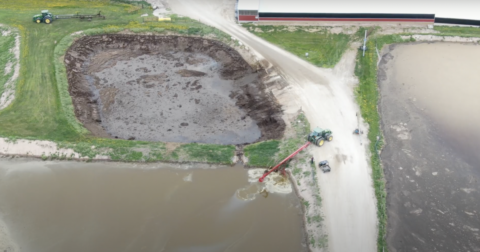Explainer
The Causes and Effects of Deforestation, Explained
Climate•8 min read
Reported
Residents that live near industrial dairies find brown drinking water flowing from the tap.


Words by Grace Hussain
“I don’t think you’d want to drink that,” said Arlin Karnopp, of the brown-tinged water inside the jam jar in front of him. Government-testing has revealed the water sample taken from his kitchen sink is contaminated with nitrates and E. coli.
Karnopp says that when he married his wife Mary Lou, they built what was to be their dream home in Kewaunee County, Wisconsin. More than five decades later, the couple now has a sign outside that reads “Grandma and Grandpa’s House.” In recent years, the land around them has changed too. Bigger dairy farms have sprung up — and more of them — some housing thousands of cows.
“They say it’s a family farm,” Arlin Karnopp told animal welfare advocacy organization Mercy For Animals, but he’s skeptical, pointing to the sheer number of employees and cattle. Now, new drone footage documented by the nonprofit confirms his suspicions. Their neighbor is a dairy farm with hundreds of dairy cows that stores manure in huge liquid lagoons. Another neighboring factory farm holds more than a thousand calves not yet old enough to become impregnated for milking.
The new aerial drone footage shows more than a dozen different industrial dairy farms in central and eastern Wisconsin, with a combined total of 28 manure lagoons, according to a Mercy For Animals representative. It reveals massive pits filled with brown sludge — a mixture of animal waste and water.
The tractors dumping into the pools appear toy-like in comparison. In many cases, vats of manure are directly next to the barns housing approximately thousands of dairy cows producing milk, all kept mostly indoors other than brief trips to and from the milking parlor.
Touted as “America’s Dairyland” by its own lawmakers in the 1940s, Wisconsin has long been famous for its dairy industry. While small-scale farmers were the norm for decades, the industry is now highly consolidated. At the end of January, the state was home to 1.27 million dairy cows on just over 6,000 farms, including 630,000 heifers — female dairy cows who haven’t given birth or produced milk yet.
That many cows produce a lot of manure: 65 pounds a day each or roughly 12 tons a year. On top of that, every cow eliminates roughly 3.5 gallons of urine each day. Some annual estimates put manure from U.S. livestock at between 1.27 and 1.37 billion tons of waste — at least three times what people in the U.S. are flushing. All of that waste has to go somewhere, and it can only be applied for crops at certain times in the planting season. Until then, it has to be stored.
The most common solution on factory farms: massive open-air cesspools filled with thousands of gallons of slurry composed of waste and water. As the vats age, they often start to crack, allowing the toxic mixture inside to seep out and make its way into the groundwater, upon which residential wells rely.
Eventually, families living nearby — like the Karnopps — turn on their faucets to find polluted, brown liquid. Now, Karnopp and his wife have to buy “gallons and gallons” of clean water for their family. “Everything we cook comes from bottled water,” says Mary Lou Karnopp.
The footage also reveals rows upon tidy rows of white hutches for housing calves, some visibly squeezed into their tiny enclosures. In 2022, Wisconsin had a “calf crop” of 1.4 million animals, per U.S. Department of Agriculture data.
Immediately after birth, calves are separated from their mothers and housed separately. One of two fates awaits them. If they are female, they are likely to be raised to replace their mothers or grandmothers as the older cows’ bodies break down under the pressures of inordinately high milk production — usually by six years old.
Or they could be sold for meat, often as part of the veal industry. The type of veal they will become determines how long the calves will live, though none of them will make it to puberty before being slaughtered.
For the Karnopps, their main concern is the health and wellbeing of their family, especially their grandchildren. On the weekends when they visit, Arlin and Mary Lou Karnopp don’t let them use the water from their faucets — not even to wash their faces — offering them wipes instead.
There is evidence to support their cautious behavior. Drinking water that contains E. coli, which has already been confirmed in the samples from their faucets, can in some cases cause diarrhea, respiratory illnesses and blood infections, according to the Centers for Disease Control.
The high levels of nitrates in their water are also dangerous — some studies link prolonged exposure to toxic levels of nitrates with higher rates of miscarriage and some types of cancer.
“We have to make sure we always have water. We can’t run out because we can’t just turn the faucet on,” Mary Lou Karnopp says. “We shouldn’t have to live like this.”